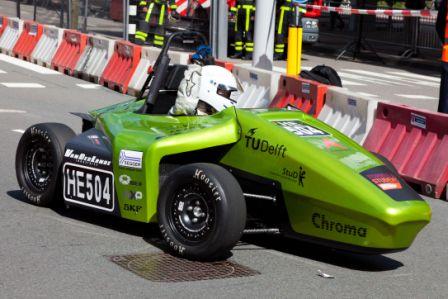Scientists at the VU University Amsterdam and TU Delft have illustrated that the release rate of hydrogen stored in a metal hydride depends on the size of the metal alloy nanoparticle. The smaller the nanoparticle size, the higher the release rate of hydrogen that moves into the fuel cell.
 The TU Delft Forze IV hydrogen race car
The TU Delft Forze IV hydrogen race car
This finding can be utilized to enhance the hydrogen storage efficiency in vehicles. The results will be published in the October issue of Advanced Energy Materials journal. Metals such as magnesium absorb hydrogen gas in high densities without the requirement for high pressure. However, the drawback is that the process of hydrogen release from the metal is slow and complicated. The utilization of magnesium nanoparticles, which are attached in a matrix to avoid their aggregation, is one method of accelerating hydrogen release.
During their study utilizing models comprising titanium and magnesium thin layers, the researchers at VU University Amsterdam and TU Delft have experimentally proved that the interaction between the matrix and the nanoparticles can increase the release rate of hydrogen. They demonstrated that pressure of hydrogen gas being discharged from magnesium rises with the reduction in the size of the layers. This demonstrates that hydrogen gas can be stored in nanoparticles in a matrix. The selection of the matrix depends on the range of hydrogen desorption pressure increase.
Economical and efficient hydrogen storage methods are critical in the wide acceptance of hydrogen fuel cells. The Netherlands Organisation for Scientific Research’s ACTS Sustainable Hydrogen Program funded the research.